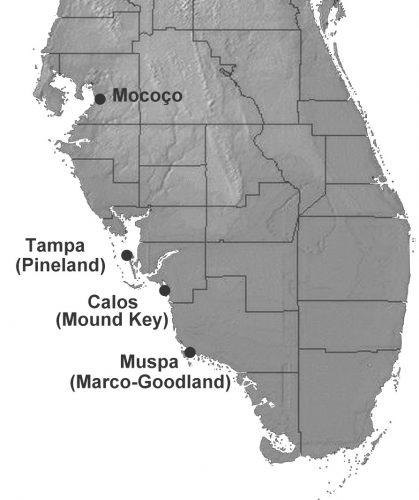The identification of the Pineland site as the likely remains of the important 16th-18th-century Calusa community of Tampa (see June, 2002 Friends newsletter, Vol. 1, No. 2, p. 3) along the northern Calusa frontier lends new significance to documentary evidence regarding Calusa-Spanish relations between 1612 and 1614, and suggests that Pineland was not only visited, but perhaps even attacked, by Spanish forces during this little-known period.

The 1611 murder of 17 Christian Timucua Indians near the mouth of the Suwannee River sparked Spanish military retaliation against the culprits, the Pohoy and Tocobaga Indians along the middle Florida Gulf coast. The swift execution of their chiefs evidently prompted the Calusa chief to acquiesce to a Spanish diplomatic mission from St. Augustine during the summer of 1612, during which a launch led by Ensign Juan Rodríguez de Cartaya traveled south along the Gulf coastline to present-day Boca Grande, entering the “River called Tampa” there and proceeding southward through Pine Island Sound and San Carlos Bay to the Calusa capital at Mound Key in Estero Bay. Pineland may even have been one of the “large settlements of Indians” along the way that initially received the Spaniards and provided “fish and other things” upon orders from the Calusa chief.
Although the Calusa chief received the Spanish emissary in peace, exchanging gifts and promising peaceful relations, in March of 1614 — less than two years later — the new Spanish governor of Florida issued a military order to Rodríguez recounting that the Calusa chief had recently sent 300 war canoes to the province of Mocoço along the southern Spanish frontier near modern Tampa Bay, killing some 500 men, women, and children in two towns there. The chief had sent a dozen survivors north to St. Augustine with threats to all other Spanish- allied Indian groups, and had even warned the governor that any Spanish soldiers he might send in retaliation would also be killed. Ignoring this warning, the governor dispatched two vessels to converge on the Calusa domain and “exact the greatest punishment possible” on the Calusa chief.
Further documentation is scarce, but financial records from early June of 1614 indicate that the launches San Martín and San Pedro (each probably carrying a crew of 25) were outfitted with munitions and supplies for an expedition that summer. Later military service records refer to the “the war that was made in the Cove of Carlos, Tanpa, Tachista, and [M]uspa” during this period, suggesting that contact was made, probably including the Pineland site. Since the expedition leader survived and was later promoted, it seems likely that his mission was at least partially accomplished.
Given typical Spanish military tactics of the era, even if Pineland had been abandoned in advance of the Spanish force, it would likely have been torched in retaliation for the Mocoço province massacre. Spanish documents are often maddenly silent on details of Calusa- Spanish relations during the colonial era, but this little-known military action in Southwest Florida during 1614 provides a tantalizing glimpse of human events that might eventually provide more information about Pineland and its neighbors within the Calusa domain.
This article was taken from the Friends of the Randell Research Center Newsletter Vol 4, No. 2. June 2005.